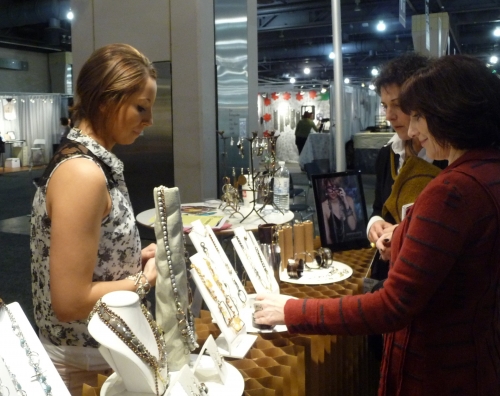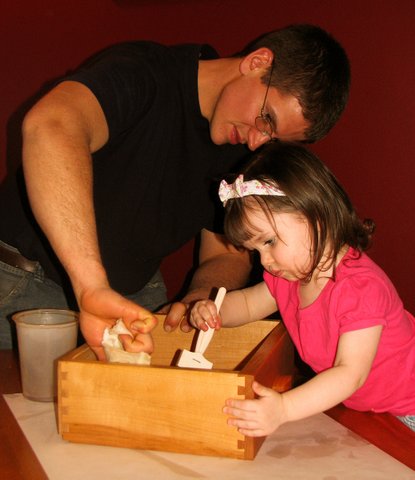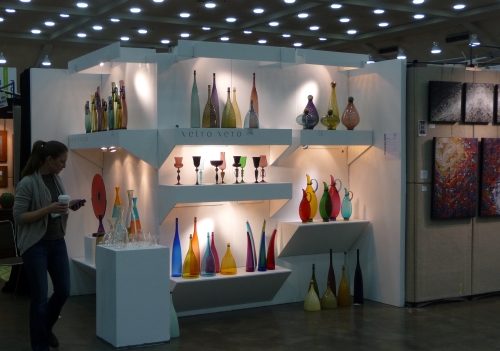By Carolyn Edlund
How artists and makers can take advantage of a sustainable business model and grow their sales.

Store buyers shop for handmade jewelry at a trade show. Photo Buyers Market of American Craft
At the end of each year, many artists are frantically busy, especially if they are traveling to retail shows and fairs, delivering commissions and making the most of the holiday rush. And after the rush is over, unless you travel south to catch the snowbirds, business can get slow . . . very slow.
It’s common for many artists and craftspeople to have a “feast or famine” type of income if they pursue only one type of selling. And although I’m all for selling retail, I discovered years ago the power of selling wholesale in my own business.
Is Wholesaling Right for You?
Selling wholesale is, of course, a standard business model – it’s how business is done in the commercial marketplace. Manufacturers ship billions of dollar’s worth of goods to retailers of all types every year. In the handmade world, quite a few retailers purchase wholesale, including gift shops, museum stores, boutiques, catalogs and many others.
Should everybody wholesale their work? No, it’s not right for everyone. If you design a line which can be reproduced in a production studio, it can be a terrific model, although even one-of-a-kind items can be wholesaled.
Does selling wholesale meaning cutting your prices in half? No, actually that is a backwards way of thinking about it. Wholesale lines are built from the ground up, designed and priced so that they are profitable at a wholesale price, and ready to be marked up between 2 – 3 times, depending on the retailer’s policies. The artist rarely sets the retailers’ price on their items, unless they must be printed on the product, such as greeting cards and calendars.

Woodworker Matt Thomas acquired over 50 retail accounts in his first year of wholesaling.
Why Wholesaling is Sustainable
Part of the beauty of the wholesale model is that it creates repeat business. And repeat business is what grows businesses. Just as fine artists may seek to cultivate collectors, the artist who is wholesaling seeks to cultivate galleries, shops and retailers who will become ongoing accounts.
In my own business, I had business relationships with many store buyers for years. Those relationships thrived because we were making money together. It’s what earned me over a hundred steady wholesale accounts at any given time. It turned my production studio volume into six figures annually.
Speaking of money, the wholesale model brings in income on a consistent basis. This smooths out lean periods so the artist is more likely to be able to support themselves and their family. With receivables to show, the artist is also more likely to get a business loan to grow their small business, too.

Many mediums are appropriate for wholesaling, including Fiber, Metal, Clay, Photography and as shown, Glass and 2D art. Photo courtesy Buyers Market of American Craft.
How Wholesaling Grows Businesses
Artists who wholesale tend to have larger studios and volume, and they also tend to employ others. As my own business grew, I had 3 or 4 studio assistants at any given time, and was proud to be able to create jobs for others.
Wholesaling is efficient, too. Samples are made and shown, and orders are taken. You don’t have to have huge inventory before you know if an individual design will sell. Wholesaling is also a complementary model to retailing. Both models can work beautifully together. You may choose to sell all of your designs wholesale, or only some. It’s flexible, and puts you more in control.
How do you go about selling your work at wholesale? You can attend trade shows, hire sales reps, sell wholesale online, or approach store buyers yourself. There is little to stop an artist from getting started if they want to enter the world of wholesale. But there is a learning curve at first as the artist needs to understand wholesale business concepts, sales strategies and production. It’s not the model for every artist, but I know hundreds of people who successfully wholesale their work and wouldn’t change that for anything.

Another completely brilliant post from you, Carolyn. You really nailed it.
One other really fabulous part of wholesaling is how recession-proof it can be. My jewelry line was started in 1992 and over the years, whenever and wherever I saw soft markets, I was always free to find new regions with more vibrant economies. I saw virtually no change in my income in the past 10 years. When the economy tanked in 07-08 I just added more accounts in more upscale areas and spread out the risk and rewards. In fact, anyone who can increase production – add some employees and increase accounts – will have the POWER to grow in any economy.
And although I have a difficult business model because I use found-objects, I can also continue to create designs that bring higher profit margins, too. Slicing just 5 minutes off when producing an item that is a best seller, can mean great things for that bottom line! Even better: designing something (like my latest new earring that is in test phase right now) that you can make in less than 3 mins AND sell for $16.00 wholesale. It’s all part of the fun. Get creative FOR your bottom line.
The only caveat that I bring up when consulting my artist clients is “be careful what you wish for”. Remember to spread out your start-ups or – especially if you are about to do your first wholesale trade show – have some back-stock ready for immediate shipping and a calendar that you carefully fill with time for breathing. AND: can you make enough widgets each day to sustain yourself and if not, can you hire and still have the needed profits to sustain yourself. Retailing is not going to save you if you are working for free on the wholesale side of your business.
Thanks, Mckenna. Your example really shows the control that an artist has over their business, when they start to consider strategies to enhance their bottom line, serve their customers better and make good choices. Small businesses are nimble enough to make those shifts as times change – and you have proven that well!
Thanks, Carolyn! In point of fact, I watched some galleries suffer and close at the 2008 crash and at the height of job losses in a few industrial/manufacturing jobs areas. Retailers are not “mobile” – internet won’t make up for live shoppers – and they simply saw their marketplace dry up. I just quit selling to that region or did it with great protections like payments in advance of shipments. Wholesaling is magical when you use all of it’s bells and whistles.
Thanks for a fabulous article. This really inspired me and helped me to define my goals as I am in the process of writing a business plan for my art business. I wish I could be there in Philly for the workshop! I just moved to London UK. If you know of any resources of this type in London, do let me know!
Iona
Thank you, Iona – well, I don’t know of any resources in London, but I suggest you subscribe to the Arts Business Institute blog at http://www.ArtsBusinessInstitute.org, which is highly focused on wholesaling, and has many articles on different facets of the topic that you may be able to use.
This is an excellent article! I actually did try wholesale on a small scale a few years ago and now want to do it again. The ABI blog with all the links and your site with links are great places to educate myself. Does ABI share simple forms for wholesaling?
Saving up my coin to take one of the wholesale courses. I will look and see if any are offered online for those who cannot physically attend 🙂
Thanks again for such empowering articles for those who want to Earn A Living with their art!
Sue, The ABI blog (which I also write) has lots of articles about wholesaling, but I’m not sure what you mean by “simple forms” (order forms? Planners?) We would love to have you join us at one of our upcoming workshops; many events are planned for 2014. We are working on creating on online series for those who cannot physically attend, but our live schedule is so hectic right now … perhaps will happen in the fall.
You wrote my life story! I had art show burnout several years ago and would like to add that, in addition to the time, the traveling and the exhaustion, I think it takes a certain type of personality to chat and smile and interact with people for eight hours a day. I learned all the right words, knew what I was supposed to say, but like most artists, would much rather be in the studio (thank you, Alyson Stanfield!).
However, luckily for us, I think as the internet grows and more and more people take advantage of this new and growing way to sell, there will be fewer and fewer art shows and festivals. Even if you’re the type who likes doing shows, hanging out in your private zone and actually making art HAS to be a nicer alternative.
The only downside, if you want to call it that, is the learning curve that has to happen to be successful in this entirely different market. It’s just as hard, in its own way, as keeping your art safely covered while hanging on to the bars of your canopy to prevent it from blowing away in the the pouring rain and looking out at the aisles empty of all but your similarly suffering fellow artists!
If you are selling your products wholesale I would recommend having line sheets. When you meet potential buyers you need something to show them if you don’t have all your products on hand. You will have all your important product information in the line sheet to answer any questions that the buyer has.